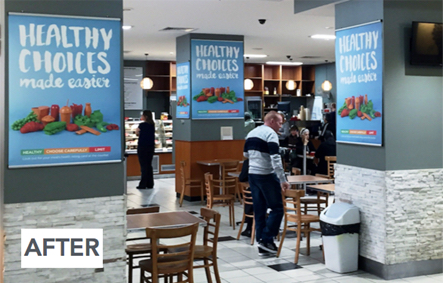Northeast Health Wangaratta (Sugar sweetened beverages)

Overview
Led by Northeast Health Wangaratta (NHW) six health services across rural east Victoria collaborated to work towards implementing the Healthy choices guidelines across the region. Learn more about their reduction of Sugar Sweetened Beverages (SSB) and uptake of Healthy Choices in Rural East Victoria.
Led by Northeast Health Wangaratta (NHW) six health services across rural east Victoria collaborated to work towards implementing the Healthy choices guidelines across the region. Learn more about their reduction of Sugar Sweetened Beverages (SSB) and uptake of Healthy Choices in Rural East Victoria.
About the case study
Background
Led by Northeast Health Wangaratta (NHW) six health services across rural east Victoria collaborated to work towards implementing the Victorian Healthy choices: policy guidelines for hospitals and health services across the region.
The health services aimed to replace any RED (limit) items with GREEN (best choices) or AMBER (choose carefully) items.
Key partners
Northeast Health Wangaratta, Cobram District Health, Alexandra Health Service, Beechworth Health Service, Yarrawonga Health and Benalla Health.
Alfred Health and the Healthy Eating Advisory Service (HEAS) supported the design and implementation of this group.
Governance
NHW CEO engaged CEOs in the Ovens Murray catchment which created authorisation for change for all health services. NHW met with the five health services, to introduce the project and facilitate planning discussions for implementation at each site.
All key stakeholders had support from their Executive and were engaged in making changes at their site. The HEAS and Alfred Health were also in attendance and were able share their learnings from the support they provide others to implement the Healthy Choices guidelines.
How – Resources, investment and information
Resources
- The Healthy Eating Advisory Service provided resources and tailored advice for each health service.
- Alfred Health assisted in ways to engage food outlets and stakeholders and helped to embed change.
Investment
- This initiative was supported by the Victorian Government.
- Leadership support inclusive of in kind and minor capital was incurred by participating health services.
Information and data
The initial goal of the project was to reduce sugar sweetened beverages (SSBs). Some health services were already well advanced at reducing SSBs and some did not have any onsite.
Differences across individual health services included:
- Food environments (not all sites had cafés; number of vending machines varied; existence of catering menus varied).
- Current levels of compliance relating to Healthy Choices guidelines.
- Readiness and capacity to change to meet Healthy Choices guidelines (relating to organisational barriers)
The change
Our plans for change
- Develop a catering policy.
- Develop a standard menu with standard recipes.
- Increase amount of GREEN options available on the menu.
- Introduction of a traffic light identification system to assist staff.
- Communicate changes to staff, volunteers and the community (to raise awareness of Healthy Choices and highlight the importance of health and wellbeing).
Workforce
Three sites focused on their staff meals/snack baskets, two sites focused on their catering/function menus and two sites assessed the content of their vending machines. Support from NHW’s Health Promotion Officer was provided to assist all sites to assess the percentage of GREEN, AMBER and RED food and drinks using the Healthy Eating Advisory Service FoodChecker tool.
Reasons for participation
- “To promote and support better health outcomes, to show leadership” – Beechworth Health Service
- “Sugar sweetened beverages are a big contributor to poor health outcomes” -Yarrawonga Health
- “We want to provide healthier options for staff and visitors & promote choosing a healthier alternative” – Cobram District Health
- “To promote healthy eating” – Benalla Health
Success, barriers and achievements
Keys to success
- CEO/Executive support/engagement.
- Communication strategy using newsprint media, Facebook, forums, newsletters and email promotions.
- Relationships with and involvement of food service staff for implementation.
- Dedicated healthy workplace team including senior management, clinical staff and volunteers.
- User-friendly Healthy Eating Advisory Service tools.
- Use of dietetics students to undertake a large menu review.
- Support from other health services (mentorship and coaching and regional collaboration/networking).
- Provision of support from lead agency to provide guidance and maintain engagement.
Barriers to implementation
- Volunteer-led retailers making it more challenging to enforce change.
- Inadequate time and resources for key champions and leads within health services.
- Staff averse to the removal of vending machines.
- Staff averse to making changes to include healthier choices and reduce RED and AMBER food and drinks.
- Customer perception that choices are being ‘forced’ onto them.
- Health services being at different levels of progress requiring innovative thinking to keep the project on track.
Achievement highlights
Vending machine changes at Cobram District Health
- This project brought the rural health services together. Prior to participating, some health services were not aware of the Healthy Choices guidelines. All now have individual health service specific plans and are engaged in their Healthy Choices journey with support from the Healthy Eating Advisory Service.
- Three sites are developing organisational wide Healthy Choices policies.
Café menu change at Northeast Health Wangaratta
- NHW commenced their Healthy Choices journey in 2016-17. As part of this project they increased the provision of GREEN food and drinks in the cafeteria.
- Engagement through this project increased the number of customer purchases. NHW café is predicting a $23K increase in revenue in 2018-19.
Future considerations
- Consultation with the lead regional health service during the development phase to identify the differing food environments, barriers, readiness and capacity to implement change across the rural health services may have made the objectives of the project clearer.
- Communication was key. Future projects should look to create an environment where all key stakeholders feel safe to communicate openly from the outset regarding their goals, plans, readiness and capacity to change. This would allow clarity and reduce confusion regarding realistic aims during the project timeframe.
- Incorporate social and print media, and use internal communication pathways to report on key outcomes and planned changes throughout the process.
- A shared information and networking platform between all participating health services across the state to discuss strategies, learnings and key messages is beneficial.
Relevant case studies

- Health services
- Implementing healthy changes
- +1

- Health services
- Implementing healthy changes

- Health services
- Implementing healthy changes
- +1

- Health services

- Health services
- Implementing healthy changes
- +1
Register your interest
"*" indicates required fields









